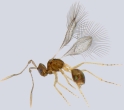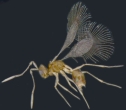 |
Scientific nameMymaromma sp.
Taxonomic positionHymenoptera: Mymarommatoidea: Mymarommatidae
Diagnosis
Mymarommatidae can be diagnosed by the following combination of characters: (i) head has a hyperoccipital band of pleated membrane that enables the occipital region to expand and contract in a bellows-like manner, (ii) forewing membrane with a mesh-like pattern, (iii) hind wing reduced to an apically bifurcate haltere-like structure, and (iv) petiole composed of two tubular segments.
Females of the genus Mymaromma are characterized by: Head with or without ocelli. Female flagellum with 6 or 7 funicular segments and 1-segmented clava or 7 funicular segments and 2-segmented clava. Protibial calcar straight, simple. Propleura fused into carapace. Mesopleuron and metapleuron usually fused, rarely partly or completely separated by suture. Propodeum posteriorly reflexed into >-like flange over petiolar insertion, the postero-ventral margin of flange and projection of metapleuron forming pincer-like structure. Forewing often appearing more or less lanceolate, the disc longitudinally convoluted with hair-like setae aligned along folds on dorsal and ventral surfaces, and sometimes densely hairy if setae very long; posterior margin usually with basal seta conspicuously longer than adjacent short setae. Metasoma with Mt1 longer than Mt2 but their relative length variable (From Gibson et al., 2007). ImagesWorld species of Mymaromma
1. Mymaromma anomalum (Blood & Kryger)
2. Mymaromma buyckxi Mathot 3. Mymaromma goethei Girault 4. Mymaromma mirissimum (Girault) 5. Mymaromma ypt (Triapitsyn & Berezovskiy) Distribution
India: Tamil Nadu, Arunachal Pradesh, Karnataka.
Biology / HostsPromecotheca cumingii (Chrysomelidae) (Mymaromma anomalum).
References
CreditsFactsheet prepared by Dr. A. Rameshkumar, Research associate, NPIB, NBAIR.
|


